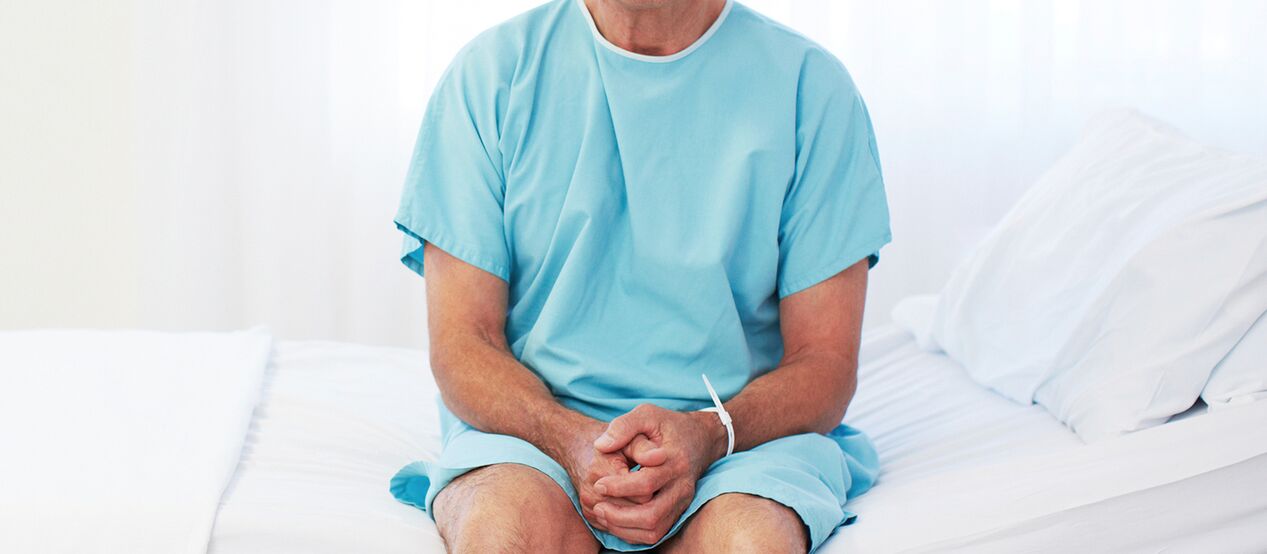Prostatitis is an inflammatory disease of male prostate located directly below the bladder and is a secondary part of the genital.
Every 7 men aged 35 suffer from prostatitis, and with each naked risk of developing the inflammatory process in the prostate increases under the influence of external and internal factors.
Reasons

Invalid inflammation in a reason can be developed for various reasons, doctors differ mainly than them:
- Violation of blood microcirculation in pelvic authorities - This leads to stagnant processes and helps increase the size of the prostate. Stagnant processes make it easier for obesity and spending a seated sitting lifestyle.
- Entry of bacteria, viruses or protozoes against the background of an acute or chronic inflammatory process in other bodies - such diseases as angina, gonorrhea, urethritis, cystitis, flu, pyelonephritis can cause prostatitis. Causal infection agents can enter the prostate of blood and lymph flow if there is an infection of remote areas and organs.
- Injuries and bruises soft tissues of abdomen, perineum and external genitalia - this leads to edema and damaged blood circulation in damage zone;
- Body hypothermia.
- Chronic prison.
- Hormonal disorders.
- Stormy or, vice versa, sexual life is harmful, and frequent gender (more than one time a day), as well as rare intimate relationships (less often 1 time a week), as it leads to sexual glands or stagnation in prostate.
Prostatitis symptoms
Distinguish between an acute and chronic form of illness.
Acute prostatitis is characterized by a sudden start from the background of the general well-being, which is clinically accompanied by the following symptoms:
- coldness and weakness;
- General Malase;
- increased irritability and nervousness;
- Increasing body temperature (not greater than 37, 5 degrees);
- pulling or cutting pain in the lower abdomen and in the perineum;
- Frequent urine for urinating while preserving the feeling of incomplete bladder discharge;
- River pain and difficulty with bowel movements.
In the absence of diagnosis and timely treatment, acute prostatitis can be complicated, pus and pus commissioning from uretra during urination.
Signs of chronic prostatitis
In the transition of disease in a chronic exchange rate form, clinical signs of prostatitis and patient are recovery. The characteristic characteristics of a chronic inflammatory process in the spent gland burns along the urethra with radiation in the groin, which can be improved during urination and defection. Gradually, the disease is advancing and causing immorality. Chronic prostatitis implies the period of remission and deterioration, but even in times of deterioration, symptoms will be deleted, not as pronounced as in acute form. The following symptoms appear clinically:
- difficulty with erection;
- Inability to complete sexual intercourse with ejaculation;
- Reduction of sexual drive;
- Exaction from the urethra serves with the addition of white flakes;
- a sense of incomplete bladder discharge;
- Withdrawal of lower back pain, pubis and groin;
- Weak urine stream - This is observed as a result of the narration of the lumens of the urethra on the background of its compression extended prostate.
The chronic disputed inflammatory process in urea is irritating the nerve ends of the pelvis and causes constant urination, especially at night. Many men are uncomfortable to see a doctor with such a sensitive problem, which increases the risk of developing such serious complications as complete erectile dysfunction, infertility, and even prostate cancer.
In addition, from the focus of a chronic infection in a prostate with blood flow and lymph, pathogens enter the kidneys, causing acute inflammation, urinary retention and increases the risk of kidney failure.
Permanent accumulation of urine in the bladder and urethra creates favorable conditions for forming salt crystals, and then stones - very often prostatitis in men continues in parallel.
Diagnostic methods
Diagnosis, treatment and prevention of prostatitis is performed by a doctor urologist. To make a diagnosis, determine the form and cause of the inflammatory process in the prostate prostate, a series of exams is prescribed:
- Prostate palpation - is implemented through the rectum and allows you to reveal the magnification, pain, pus or mucus after palpation;
- Small discharge from the urethra - the resulting material is sent to study laboratories;
- Urine analysis is general etc. ;
- Ultrasound of pelvic organs and prostate glands.
If the pathological process is the suspects for the spread of the patient process, the patient is additionally implemented by cystoscopy - testing of bladder walls using a flexible device equipped with an optical system at the end.
In the diagnosis of prostatitis, it is very important to distinguish the pathological process from the adenoma prostate and other urological diseases with a similar clinical course.
Treatment

The treatment of acute and chronic form of prostatitis differs, so patients are strongly recommended not self-identified.
Acute intact form of prostatitis is treated comprehensively using plant preparations and anti -infalmotor drugs.
Treatment of acute bacterial prostatitis
The principles of therapy for acute form of bacterial prostatitis depend directly on how pronounced symptoms of the disease.
The distinct bacterial prostatitis characteristic is an acute start and quick increase signs of body intoxication - nausea, vomit, headache, high body temperature. The bladder emptying process is accompanied by a reduction in pain in the lower abdomen and in the perineum that is given to the lower back. Very often, the gnote process is joined and the abscess develops.
The treatment of acute bacterial prostatitis is carried out in the hospital, because the patient's condition can be extremely serious. Therapy consists in a complex approach:
- Patient must observe bed resting;
- Antibiotics - macrolides, fluoroquinolons, cephalosporines are prescribed;
- Preparations were selected that improve blood microcirculation in pelvic authorities. Enable the outflow of lymph and venous blood, which reduces the seriousness of the edema and the inflammatory process in the prostate;
- Inside orally, drugs from non-asteoid anti-alflamatory drugs are shown. These drugs not only reduce the inflammatory process, but eliminate pain syndrome;
- Analgesics - You can take pills within or import rectal candles in the rectum;
- To remove body intoxication, the physiological solution of sodium with glucose is intravenically prescribed.
Important! The prostate massage is strictly prohibited, because the risk of sepsis is high.
Surgical treatment
The surgical intervention for prostatitis is only needed if the patient develops a sharp delay in urine and there is no way to empty the bladder. You cannot do without surgery and in case of a prostate apse.
The course of prostatitis treatment lasts 14 days, after which the patient re-conducts a comprehensive examination for the effectiveness of therapy efficiency. If necessary, the treatment course is extended and adjusted.
Chronic treatment
The treatment of chronic prostatitis differs and largely depends on what is the path phase pathological process. In the event of an exacerbation of the inflammatory process, therapy is made similarly, as in acute prostatitis.
Treatment of chronic prostatitis during remission is as follows:
- Enter the exchange rate of non-asteoid anti -infalmator drugs. Present drugs 2 times a day for at least 3 days, sometimes up to 5 days.
- Preparations that contribute to improving venous and lymphatic outflow.
- Immunomodulators.
- Antidepressants and sedatives help in the normalization of sleep, eliminates irritability.
- Polyvitamin complexes rich in zinc, selenium, vitamins of Group V.
In the phase of the remice of the pattern prostate, the patient is shown in physiotherapy treatment:
- Prostate massage;
- ultrasound;
- electrophoresis;
- Magnetotherapy;
- Microwave hyperthermia.
Surgical treatment of chronic prostatitis
With neglocated chronic prostatitis, the patient sometimes need an operation. It can be performed in two ways:
- Transuretral resection;
- Prostratektomije.
Transator resection
This method of surgical treatment refers to minimal invasive interventions, although it is performed under general anesthesia. During the proceedings, a resectoscope was introduced within the urethra, through which electric current impulses are delivered. These electrical impulses operate on the principle of electric noise and partially remove prostate tissue. Huge plus these methods of intervention is a lack of blood loss, because electric waves do not only remove the prostate tissues, but immediately treat blood vessels, preventing bloody vessels.
Transuretral resection significantly facilitates the patient's condition - after surgery, urination returns, man no longer burns in her crotch, does not enter the toilet at night in the toilet. Erectile functions and normal ejaculation have been renewed. The entire process of operation controls the doctor on the monitor screen, so that the risk of complications during operations or immediately after it is minimal.
Prostatectomy

Prostratektomy is serious abdominal work and is always associated with risks for the patient. During the operation, the doctor completely removes prostate or most. The recovery period is 4-6 weeks, there is a high risk of developing postoperative complications, but sometimes this method of surgical intervention is the only way to mitigate the patient's condition and eliminate the consequences of a difficult prostatitis point.
Other methods of treatment of chronic prostatitis
Other methods of treatment of chronic prostatitisual forms include:
- Hyricultomyapy - or treatment for leeches. Medical PileChes are installed in a burning zone, which is released in the process of their actions, which delivers blood, which eliminates standing phenomena and quickly relieves the inflammatory process. Leeches are used only with special, medical, individuals for each individual patient. After the proceedings, the doctor puts used leeches in the nine in which she dies. It is optimal to undergo at least 5 hours of surgotrothage courses.
- KRIVATE - Liquid nitrogen is used. This method of treatment is shown in patients who are poorly borrowed on drug therapy, and the operation is contraindicated for some reason.
- Microwave therapy in a special way - Electromagnetic waves affect the prostate. After 1 procedure, tissue edemi decreases, blood circulation is normalized, and stagnation is eliminated. After conducting the flow of electromagnetic therapy, the patient completely returns urination and erectile function.
- Healing ultrasonic waves - allows you to quickly stop the inflammatory process that occurs in the remission phase, and ultrasound therapy does not implement during worsening. To improve the therapeutic effect, medications can be additionally used, which under the influence of ultrasound penetrates directly into prostate tissue.
- Uretra stenting - The essence of the procedure is to install a special stant in urea, which expands Lumen urethra and promotes a normal effusion of urinary urine. Despite the efficiency of the procedure, the stentation of the urethra is removed only by clinical symptoms of prostatitis, but the patient does not save from a chronic inflammatory process.
Consequences and complications
In the absence of qualified therapy, prostatitis progresses quickly, transitions into a chronic electricity form and threatens human health to their heavy complications, including:
- Urolithiasis;
- Pyelonephritis;
- Abscess development;
- spreading the inflammatory process on the testicles and seed ropes, leading to infertility;
- Erectile dysfunction and impotence;
- Necrotic changes in the prostate gland tissues.
Sometimes a long time prostatitis and chronic stagnant processes give an incentive to degeneration of disease in Aden, then prostate cancer.

































